Help Your Herd Cruise through Winter’s Rage
Todd Amenrud | Originally published in GameKeepers: Farming for Wildlife Magazine. To subscribe, click here.
It seems during the past few years our winter’s severities have gone from one end of the spectrum to the other. The 2014-2015 winter was one of the coldest on record, but the 2015-2016 winter hardly showed up at all. Winters nationwide, however, have been growing colder for the past 20 years, and over the past five years, record cold temperatures have been set from Florida to Michigan. Cold temperatures and deep snow can have a devastating influence on a whitetail’s health and indeed whether they live or die. Gamekeepers should do their best to provide whatever necessary to help their herd through winter and reduce stress levels wherever possible.
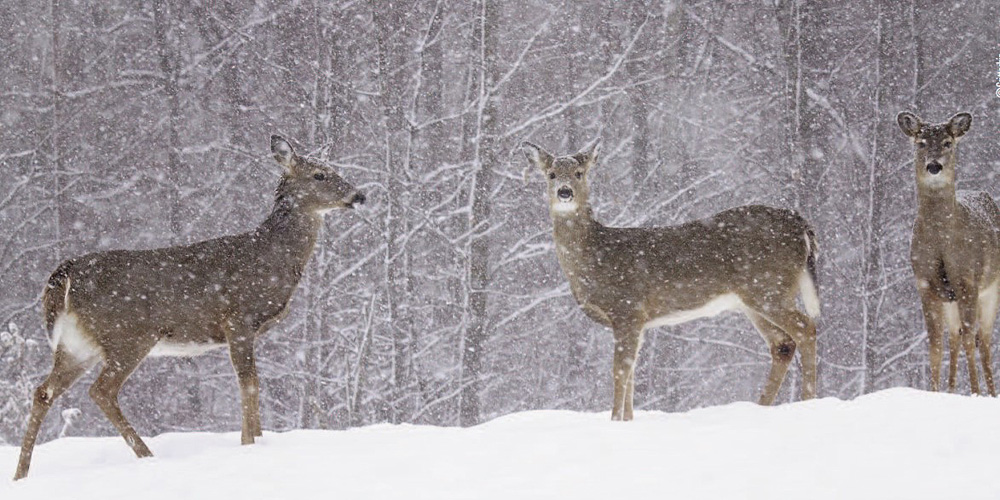
Although deep snow and below zero temperatures may not happen daily in the south, managers here should also heed these words and do their best to improve winter conditions for the animals within their reach. Unexpected cold temperatures or snow cover, while they might not create the “life and death struggle” some northern herds go through, it can mean the difference between a population that achieves their genetic potential and one that struggles and shows a decline in recruitment, antler and body size and overall herd health.
North of the Mason-Dixon Line, I have always thought that wintertime nutrition was an extremely important detail in maximizing antler growth. Most managers fail to provide adequate wintertime nutrition, whether it’s in the form of natural browse, food plots or supplemental feed. Instead they seem to be overly concerned with “attraction for the hunting season.” However, if a buck doesn’t need to rob their reserves to fill nutritional needs during winter then they’re able to reap the rewards of abundant nutrition during spring and summer rather than trying to scramble to catch-up to put all the fat back on. Year-round nutrition is important, but to me it seems commonsensical to “provide more when they have less.”
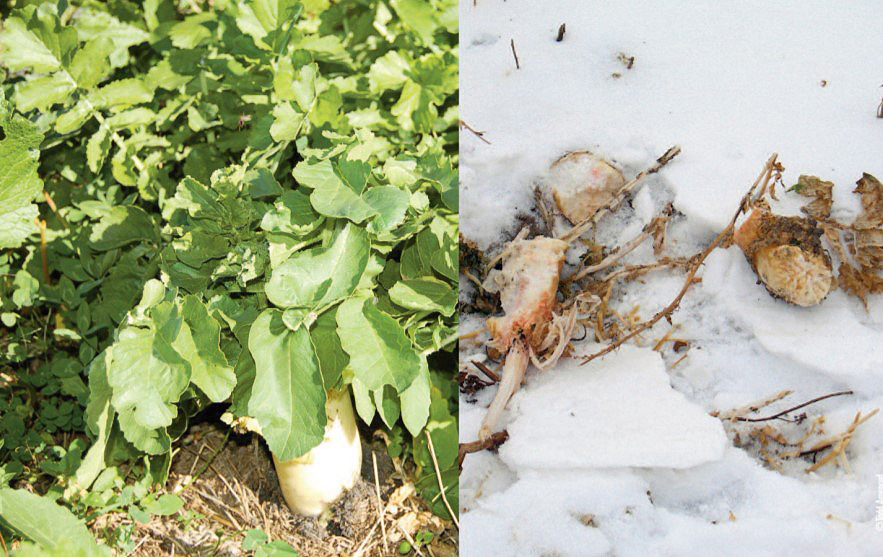
During tough times of heavy snow and extreme cold temperatures, every day a whitetail cannot find food or isn’t able to forage they must burn fat reserves to stay alive. Researchers at the University of New Hampshire found that an average adult doe has a three-month supply of body fat when she enters into winter. If she can’t take in more, she will be forced to live off of this stockpile. The colder it is and deeper the snow, the more fat she will burn through. Once the fat reserves are exhausted their bodies begin to burn muscle. This will happen until in the end it will cause starvation and death.
The Winter Severity Index
The Winter Severity Index or “WSI” is a measurement that many managers and researchers throughout the north use to determine how nasty Old Man Winter is during a given year. From the beginning of December through the end of April it’s used to track temperature and snowfall. It gives each a numeric value and this is used to quantify the impact on deer.
Any day the temperature dives to zero or below gets counted as a 1. Any day where the snow depth is 18 inches or more also gets scored as a 1. As an example, if during March there were 7 days with temperatures that were zero or below and 12 days when the snow depth was deeper than 18 inches, March would have a score of 19. Any “seasonal score” of 50 or under and it’s considered a mild winter, 51 to 80 is measured as moderate, and 80 or above is severe. If during the period of December through April it collectively goes over 100 it’s considered very severe.
Since conditions vary so much it is best to gather your own data and calculate your own WSI. Many of you have likely experienced the same thing as me—I have friends in the region and we frequently talk. When weather fronts move through oftentimes one of us will get ½ inch of rain and 10 miles away another will receive none. This can happen the same way for snow and temperatures. In addition to a front’s discrimination to disperse snow and rain where it pleases, you may have southern facing slopes or more thermal cover so temperatures can vary widely, and because of this the same may be true for snow cover. Granted, most reading this piece likely know if their local deer herd is experiencing a bad winter or not, but the WSI is a measurement to compare areas and contrast how bad a winter is from year to year.
If you don’t have the tools necessary to collect all the data, there are numerous websites, programs and apps that can help you. One used by most researchers is the National Weather Service at www.weather.gov.
What to do, what to do?
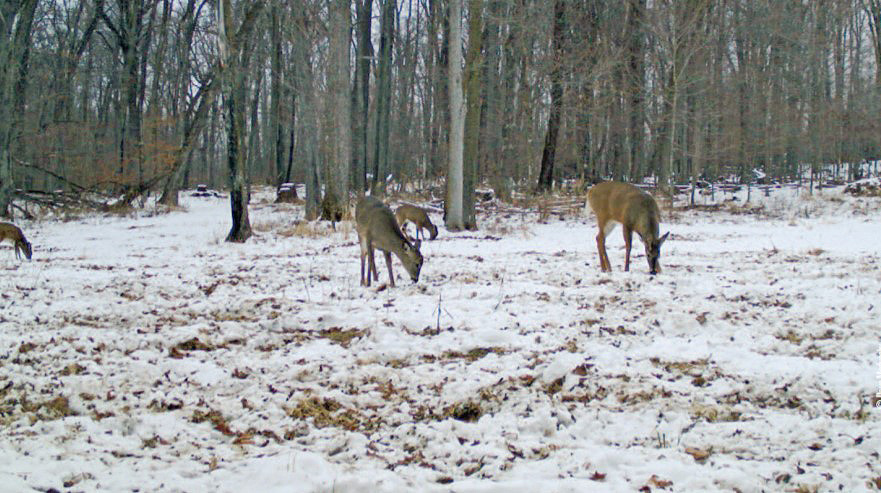
Providing food, thermal cover and low stress are the three details at the top of my winter deer survival effort on my home in Minnesota. Often the worst threat comes near the tail end of winter and into early spring when their fat reserves are drained. Deep snow or chilling temperatures that persist into spring can be devastating. An early spring bringing relief during winters like these can literally mean the difference between life and death for a whitetail.
The foods that stand above all else for wintertime nutrition and whitetails’ survivability are brassicas and corn… for many reasons. First and foremost, it has to be accessible. If food is buried under 15 inches of snow and ice it does your whitetails little to no good at all. In such a case they will likely burn off more energy than they take in from laboring to retrieve the food.
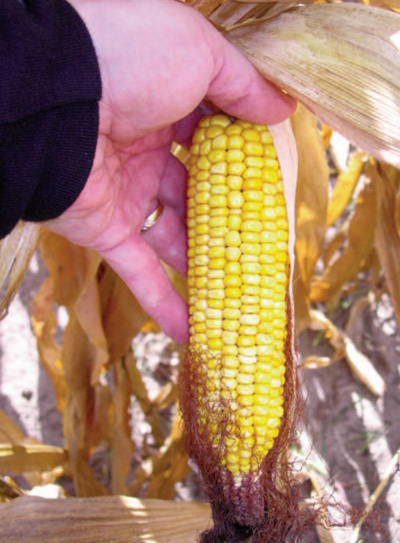
compared to other crops, but it does have a fat content of
around 4 percent and is loaded with carbohydrates in the
form of highly digestible starch. This can mean greatly
needed energy. When fed as a supplement, corn should be
only a part of a diverse diet and should be made available
all winter long.
Obviously obtainable food plot acreage comes into play for this mission because brassicas and corn are also two of the most attractive plant types to whitetails and you don’t want the crop browsed down lip-high by the end of December. So you must provide enough acreage in food for the amount of mouths you have if this source is to last into spring.
If you don’t have enough acreage, it is possible to “throttle” your food plots through fall and winter. Use fencing or P2 Plot Protector to release some food periodically. This way you can use some for hunting time attraction, but still keep reserves available for winter stress periods. If it’s a permanent problem setting up an electric fencing option is likely best. However, P2 Plot Protector works great and can be set up very quickly.
When it comes to winter food, all whitetail hunters think of “corn.” However, if I had to choose I’ll take brassicas over corn any day of the week. Brassicas outperform corn in basically every characteristic accept one – however, it depends upon how it’s measured. While both are high in carbohydrate content and provide energy in the form of natural sugars and complex starches, corn does outperform brassicas in this one quality when measured by volume. A cup of corn has more carbohydrates than a cup of brassica leaves. However, when measured per acre, brassicas churn out so much greater yield that they outperform even corn when measured this way.
Ideally, a well-rounded food plot program will have acreage devoted to both, corn and brassicas and numerous other plantings. Further south the options are plentiful and other plants can be considered, but brassicas would still be at the top of the list.
If you don’t have the acreage available you can help by coaxing more from your native sources or supplemental feeding (where legal). Hinge-cutting trees from December through March is one of my favorite ways of providing browse to the herd. It’s kind of weird in that browse is such a terrible food source, it’s low in nutrients and difficult to digest, but whitetails seem to be addicted to it. In the big woods of northern Minnesota I’ve seen whitetails actually come running to the sound of a chainsaw (more than once) especially when around logging operations. They learn the chainsaw sound means there will be accessible browse. The areas you cut will now be open to the sun and generate more stem density the following year, so besides the hinge-cut trees providing extra food for several years, you will have the bonus of production wherever you allowed the sun to reach.
You may also plant more browse or fertilize patches of browse. Years ago I used to plant hundreds of red osier dogwood, blackgum, greenbrier and other browse species. I don’t know if I’m older and lazier, or older and wiser, but in recent years I prefer to let the chainsaw do the work and Mother Nature decide the browse species which will grow best on the site.
I know fertilizing browse may sound strange, but it also works. Just like fertilizing your food plot crops, if the nutrients go into the soil, they show up in the plant and are then accessible to your deer. These low, brushy browse areas also can add to your thermal cover.
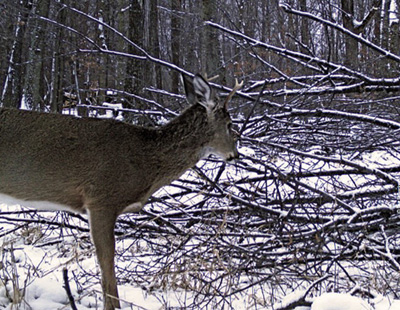
Felling or “hinging” trees so the animals can access the
treetops is a way the author likes to provide winter browse.
Whitetails have been known to come to the sound of a
chainsaw once they learn it means easily accessible
browse.
Supplemental feeding may be a tactic you wish to implement as well. This is especially true in settings or situations where you cannot provide enough acreage for the amount of mouths that you have to provide for. As most of you know, this is a more serious and detailed subject than simply dumping corn on the ground. Educate yourself on what to feed and make sure you follow through with your program. Weaning your herd onto a supplement like Record Rack Sportsman may be your best route. This will provide your herd much more than corn and there are several formulas to give your herd specific nutrients and functionality to support healthy digestion, growth and performance at different times of the year.
Thermal cover and wind breaks are also an important consideration. You may have awesome winter food available, but if your herd loses all the energy they’ve taken in to exposure to the elements, it really doesn’t matter. I’m very high on conifer trees to help in both areas - thermal cover and wind-block. My favorite trees for this are spruce, but I also plant white pine, red pine and in some cases cedar and balsam fir. The latter two are also excellent browse so in most cases they will need to be protected during early growth. These dark green trees absorb the sun’s energy and warmth and their wind-blocking boughs hold on to the heat during cold nights. The white pine and spruce grow relatively quickly while the others moderately fast.
Regardless of what your WSI turns out to be for the winter, a manager should prepare for the worst. There are other things we can do to help our herd handle a harsh winter besides the habitat work, supplemental feeding and food plots. A gamekeeper should use their trigger-finger to keep numbers at manageable levels and well below the area’s carrying capacity. Remember, this all takes time and is an ongoing endeavor, however, if you follow these ideas you should begin to see a noticeable difference after one year.






























